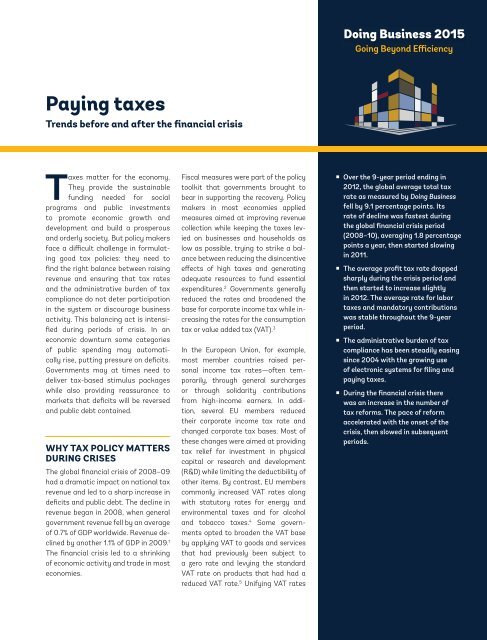bc8G2-7
bc8G2-7
bc8G2-7
You also want an ePaper? Increase the reach of your titles
YUMPU automatically turns print PDFs into web optimized ePapers that Google loves.
Doing Business 2015<br />
Going Beyond Efficiency<br />
Paying taxes<br />
Trends before and after the financial crisis<br />
Taxes matter for the economy.<br />
They provide the sustainable<br />
funding needed for social<br />
programs and public investments<br />
to promote economic growth and<br />
development and build a prosperous<br />
and orderly society. But policy makers<br />
face a difficult challenge in formulating<br />
good tax policies: they need to<br />
find the right balance between raising<br />
revenue and ensuring that tax rates<br />
and the administrative burden of tax<br />
compliance do not deter participation<br />
in the system or discourage business<br />
activity. This balancing act is intensified<br />
during periods of crisis. In an<br />
economic downturn some categories<br />
of public spending may automatically<br />
rise, putting pressure on deficits.<br />
Governments may at times need to<br />
deliver tax-based stimulus packages<br />
while also providing reassurance to<br />
markets that deficits will be reversed<br />
and public debt contained.<br />
WHY TAX POLICY MATTERS<br />
DURING CRISES<br />
The global financial crisis of 2008–09<br />
had a dramatic impact on national tax<br />
revenue and led to a sharp increase in<br />
deficits and public debt. The decline in<br />
revenue began in 2008, when general<br />
government revenue fell by an average<br />
of 0.7% of GDP worldwide. Revenue declined<br />
by another 1.1% of GDP in 2009. 1<br />
The financial crisis led to a shrinking<br />
of economic activity and trade in most<br />
economies.<br />
Fiscal measures were part of the policy<br />
toolkit that governments brought to<br />
bear in supporting the recovery. Policy<br />
makers in most economies applied<br />
measures aimed at improving revenue<br />
collection while keeping the taxes levied<br />
on businesses and households as<br />
low as possible, trying to strike a balance<br />
between reducing the disincentive<br />
effects of high taxes and generating<br />
adequate resources to fund essential<br />
expenditures. 2 Governments generally<br />
reduced the rates and broadened the<br />
base for corporate income tax while increasing<br />
the rates for the consumption<br />
tax or value added tax (VAT). 3<br />
In the European Union, for example,<br />
most member countries raised personal<br />
income tax rates—often temporarily,<br />
through general surcharges<br />
or through solidarity contributions<br />
from high-income earners. In addition,<br />
several EU members reduced<br />
their corporate income tax rate and<br />
changed corporate tax bases. Most of<br />
these changes were aimed at providing<br />
tax relief for investment in physical<br />
capital or research and development<br />
(R&D) while limiting the deductibility of<br />
other items. By contrast, EU members<br />
commonly increased VAT rates along<br />
with statutory rates for energy and<br />
environmental taxes and for alcohol<br />
and tobacco taxes. 4 Some governments<br />
opted to broaden the VAT base<br />
by applying VAT to goods and services<br />
that had previously been subject to<br />
a zero rate and levying the standard<br />
VAT rate on products that had had a<br />
reduced VAT rate. 5 Unifying VAT rates<br />
• Over the 9-year period ending in<br />
2012, the global average total tax<br />
rate as measured by Doing Business<br />
fell by 9.1 percentage points. Its<br />
rate of decline was fastest during<br />
the global financial crisis period<br />
(2008–10), averaging 1.8 percentage<br />
points a year, then started slowing<br />
in 2011.<br />
• The average profit tax rate dropped<br />
sharply during the crisis period and<br />
then started to increase slightly<br />
in 2012. The average rate for labor<br />
taxes and mandatory contributions<br />
was stable throughout the 9-year<br />
period.<br />
• The administrative burden of tax<br />
compliance has been steadily easing<br />
since 2004 with the growing use<br />
of electronic systems for filing and<br />
paying taxes.<br />
• During the financial crisis there<br />
was an increase in the number of<br />
tax reforms. The pace of reform<br />
accelerated with the onset of the<br />
crisis, then slowed in subsequent<br />
periods.


